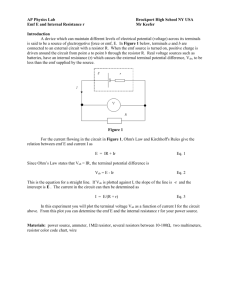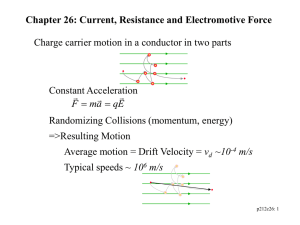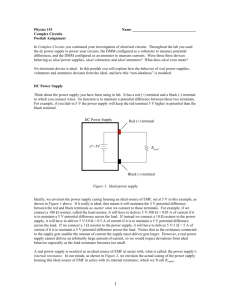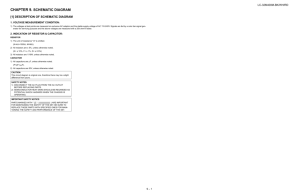lab6
advertisement
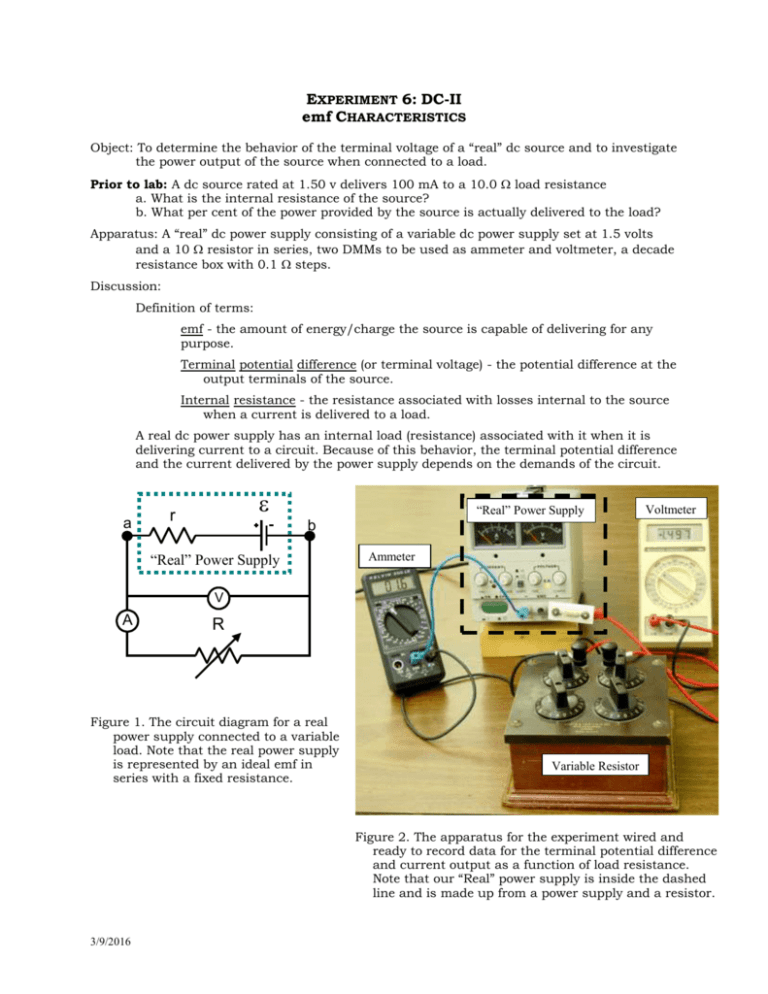
EXPERIMENT 6: DC-II emf CHARACTERISTICS Object: To determine the behavior of the terminal voltage of a “real” dc source and to investigate the power output of the source when connected to a load. Prior to lab: A dc source rated at 1.50 v delivers 100 mA to a 10.0 load resistance a. What is the internal resistance of the source? b. What per cent of the power provided by the source is actually delivered to the load? Apparatus: A “real” dc power supply consisting of a variable dc power supply set at 1.5 volts and a 10 resistor in series, two DMMs to be used as ammeter and voltmeter, a decade resistance box with 0.1 steps. Discussion: Definition of terms: emf - the amount of energy/charge the source is capable of delivering for any purpose. Terminal potential difference (or terminal voltage) - the potential difference at the output terminals of the source. Internal resistance - the resistance associated with losses internal to the source when a current is delivered to a load. A real dc power supply has an internal load (resistance) associated with it when it is delivering current to a circuit. Because of this behavior, the terminal potential difference and the current delivered by the power supply depends on the demands of the circuit. a r “Real” Power Supply Voltmeter b “Real” Power Supply Ammeter V A R Figure 1. The circuit diagram for a real power supply connected to a variable load. Note that the real power supply is represented by an ideal emf in series with a fixed resistance. Variable Resistor Figure 2. The apparatus for the experiment wired and ready to record data for the terminal potential difference and current output as a function of load resistance. Note that our “Real” power supply is inside the dashed line and is made up from a power supply and a resistor. 3/9/2016 The terminal potential difference of the power supply is Vab = IR, (1) where I is the current through the load resistance and R is the load resistance itself. (See Figure 1) Also referring to Figure 1, Vab Ir (2) Combining (1) and (2) yields: IR = - Ir (3) In addition one can calculate the power delivered by the source to the load Pout = I2R (4) whereas the source is delivering P = I. Multiplying (3) by I yields I2R = - I2r (5) Solving (3) for I yields I (6) Rr I 2R R R r 2 Pout The graph of equation (2) yields a linear equation as shown below in Figure 3. 1.5 2R R r 2 (7) The graph of equation (7) produces a curve shown in Figure 4. The peak of the curve occurs when R = r. Can you prove this to be true from equation (7)? 0.06 1 Vab 0.04 0.5 Pout 0 0.02 0 0.05 0.1 I 0.15 0 0 50 R 3/9/2016 100 PROCEDURE: 1. Wire the apparatus as shown in Figure 1 and insert the ammeter and voltmeter at the appropriate points as shown in Figure 2. DO NOT TURN ON THE POWER SUPPLY UNTIL THE INSTRUCTOR HAS CHECKED YOUR WIRING AND SET THE POWER SUPPLY OUTPUT FOR APPROXIMATELY 1.5 VOLTS. Note: The voltmeter must measure the terminal potential difference of the “real” power supply, and the ammeter must measure the current through the load resistance. 2. Make a table to record current and potential difference as you vary R. Record enough data that you a. vary I from near maximum (R approximately zero) to near zero (R very large). b. record sufficient data just above and just below r that when you graph P out vs R you clearly map the peak of the curve (See Figure 4). ANALYSIS: 1. Create a table in a spreadsheet for your measured values of R, I and Vab for the source. 2. Graph voltage output (Vab ) vs. load current (I) as data points only and determine a linear trend line on the same graph. Be sure to show the equation of the trend line as well. 3. Determine and r from the equation determined in step 2. 4. Determine the uncertainty for and r by calculatine the uncertainty in your measurements, and applying equation 3 according to the following intructions. Assume that the uncertainty in your largest reading of Vab is the same as the uncertainty of . DO NOT calculate an uncertainty for every data point, but determine a range of uncertainties by considering largest and smallest values of Vab. (The calibration error of the decade resistance box is 0.1% of its setting.) 5. Calculate the power output (Equation 4) on your spreadsheet for your current-voltage data and graph this information vs. load resistance. 6. Using the and r data determined from Equation 2, calculate a predicted power output using Equation 7 and graph as a line on the power vs. load graph plotted in step 5. REPORT: 1. Your report should include a discussion on the nature of the graphs. Are and r in a range comparable to the “expected values”? Don’t forget to refer to your uncertainty values. Does the power graph have its maximum where it is expected? Discuss any sources of error in the experiment. 2. Starting with Equation 7, determine the condition for the maximum of the function and determine the value of R for which it occurs. Is the value of R confirmed by the results of your graph? What is the significance of that value? 3/9/2016

